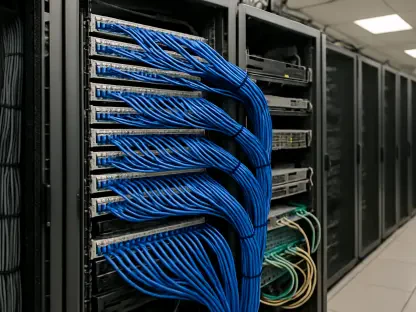Artificial Intelligence (AI) is playing an increasingly significant role in the wireless networking industry. As the demand for high-speed, reliable, and secure wireless connectivity surges, AI is emerging as a game-changer for network providers. This exploration delves into the ways AI is revolutionizing wireless network optimization and bolstering security, ensuring better performance and safeguarding data in an ever-expanding digital landscape.
The New Era of Dynamic Network Optimization
AI-driven network optimization introduces a fresh dynamic into network management, surpassing the limitations of traditional network systems that rely on static configurations. These conventional systems struggle to handle real-time network demands efficiently, often leading to inadequate performance during peak usage periods. AI revolutionizes this by integrating dynamic, adaptive capabilities that analyze massive amounts of data to enhance network performance effectively.
By predicting congestion points and reallocating bandwidth efficiently, AI can mitigate potential slowdowns, especially during peak usage times. This is particularly beneficial in high-density environments such as urban centers or large events, where thousands of simultaneous connections can stress the network infrastructure. AI ensures consistent and efficient service for users by detecting areas of high demand and automatically directing additional resources to these hotspots, preventing slowdowns or connection drops.
Moreover, AI’s ability to adapt in real-time to fluctuating network conditions means that wireless network providers can offer more reliable and responsive connectivity. This is crucial in environments where seamless service is essential, such as events with large gatherings or cities with dense populations. AI’s predictive analytics capabilities ensure that network resources are allocated optimally, thereby improving user experiences and boosting overall network efficiency.
Enhancing 5G Network Capabilities
The deployment of 5G networks demands unprecedented speed and low latency, especially for critical applications such as telemedicine, autonomous vehicles, and smart manufacturing. AI plays a crucial role in managing signal transmission with minimal delay, enabling seamless and real-time data operations crucial for these sectors. This low latency is indispensable for applications that require near-instantaneous data processing and transmission.
As 5G networks expand, AI’s role in automating operations and improving service quality becomes even more pronounced. By handling complex signal transmissions and minimizing delays, AI ensures that industries reliant on real-time data can operate smoothly without interruptions. This makes AI an integral component of the 5G infrastructure, driving forward significant advancements in wireless communication.
Furthermore, AI contributes to the efficient deployment and maintenance of 5G networks. It assists in predictive analysis of network performance, identifying potential issues before they escalate into significant problems. By enabling proactive maintenance schedules, AI helps reduce downtime and enhances the reliability of 5G connections. This automation and predictive capability are pivotal in ensuring that the high-speed, low-latency promise of 5G networks is fulfilled, supporting a range of innovative applications and services across various industries.
Strengthening Network Security
With the expansion of wireless networks comes heightened security risks, as cyber threats evolve to exploit vulnerabilities continually. Traditional security measures, often rule-based and static, struggle to keep pace with these dynamic and sophisticated threats. AI-powered security systems offer a robust solution by analyzing vast amounts of network data to detect and neutralize threats in real-time, providing a dynamic and proactive approach to network security.
AI systems continuously learn from past incidents, improving their threat detection and response capabilities over time. This continuous learning ensures that AI-powered security measures evolve with emerging threats, staying one step ahead of cyber attackers. This proactive approach is vital in countering Distributed Denial-of-Service (DDoS) attacks, preventing unauthorized access, and blocking malware and phishing threats before they reach end users, thereby safeguarding network integrity.
In addition to detecting and neutralizing threats, AI helps in fortifying authentication systems to prevent unauthorized access. By analyzing user behavior patterns, AI can identify anomalies indicative of potential security breaches, enabling swift intervention to protect sensitive data. This dynamic approach to security ensures that wireless networks remain resilient against diverse and evolving threats, providing robust protection for businesses and individuals alike.
AI in Predictive Maintenance and Troubleshooting
Network outages can be costly for businesses and frustrating for consumers, necessitating advanced solutions for maintenance and troubleshooting. AI-driven predictive maintenance helps providers identify potential problems before they escalate into significant issues. Machine learning algorithms analyze hardware performance data to detect anomalies and predict equipment failures, enabling proactive maintenance schedules that minimize downtime and ensure reliability.
This proactive approach to maintenance not only enhances overall network reliability but also reduces operational costs associated with unscheduled repairs and downtime. By predicting potential failures and scheduling maintenance tasks in advance, AI ensures that network infrastructure remains in optimal condition, thereby reducing the frequency and impact of outages.
Additionally, AI automates customer support with chatbots and virtual assistants capable of swiftly diagnosing and resolving common connectivity problems. These AI-driven support systems can handle routine inquiries efficiently, providing users with quick solutions to their issues. Complex problems are escalated to human support teams, ensuring that more intricate issues are addressed promptly and effectively. This combination of AI-driven support and human intervention enhances customer satisfaction by reducing resolution times and improving service quality.
Optimizing the Internet of Things (IoT)
The rapid expansion of IoT devices necessitates stable and efficient data communication, requiring advanced solutions to ensure seamless connectivity. AI optimizes data transmission by reducing latency and supporting efficient device-to-device communication. In smart city applications, for instance, AI prioritizes critical communications, such as emergency responses, over routine IoT data, ensuring that vital messages are transmitted promptly.
AI also strengthens IoT security by identifying vulnerabilities and blocking potential threats preemptively. This proactive approach is crucial for sectors like healthcare and industrial automation, where secure and reliable data flows are essential. AI helps to ensure that IoT networks remain resilient against cyber threats, safeguarding sensitive data and maintaining operational integrity.
Moreover, AI enhances the efficiency of IoT systems by enabling dynamic adjustments based on real-time data analysis. This adaptability ensures that IoT devices can communicate effectively even under varying network conditions. By managing data transmission more efficiently, AI supports the proliferation of IoT devices in various applications, from smart homes to industrial automation, thereby driving forward innovation and connectivity in the IoT landscape.
The Future Impacts of AI on Wireless Networks
Artificial Intelligence (AI) is becoming a pivotal force within the wireless networking sector. As the demand for high-speed, robust, and secure wireless connections continues to escalate, AI presents itself as a transformative solution for network providers. This development explores how AI is driving revolutionary changes in wireless network optimization and enhancing security measures. AI leverages sophisticated algorithms and machine learning to predict network traffic patterns, manage bandwidth allocation more efficiently, and identify potential threats before they materialize. By analyzing vast amounts of data in real-time, AI can detect anomalies and undertake corrective actions to maintain seamless connectivity. Furthermore, AI’s ability to learn from historical data enables it to refine its operations continuously. This persistent evolution is crucial for addressing the dynamic needs of today’s digital landscape. As AI’s role in wireless networking grows, it ensures better performance, heightened security, and improved user experiences in an increasingly interconnected world.









